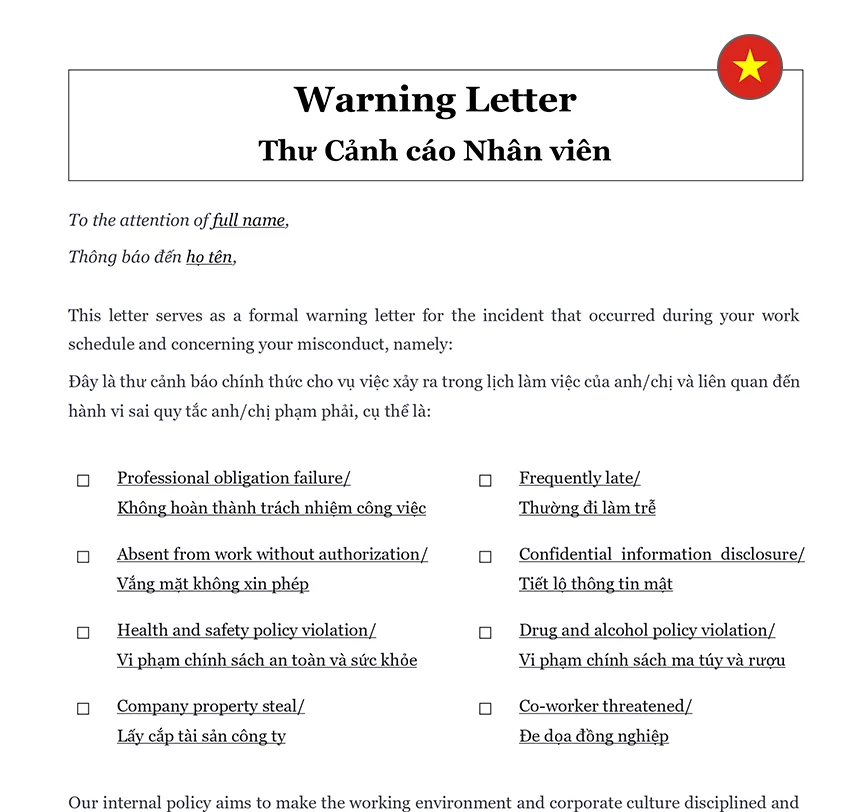Understanding Employee Misconduct
Employee misconduct encompasses a range of behaviors that violate company policies or legal standards. This includes both minor infractions, such as tardiness or unapproved absences, and more serious issues, such as theft, harassment, or substance abuse. Understanding the nature of employee misconduct is essential for addressing it appropriately and implementing effective disciplinary measures. It’s important to differentiate between misconduct that can be resolved through corrective action and more severe behavior that may warrant termination. Properly identifying and categorizing misconduct helps in choosing the right approach to handle the situation and maintain a productive work environment.
Legal Framework for Employee Misconduct in Vietnam
In Vietnam, the legal framework governing employee misconduct is outlined in several key documents:
Labor Code 2019: This is the primary legislation that regulates employment relationships in Vietnam, detailing the rights and responsibilities of both employees and employers. It provides guidelines on handling disciplinary actions, termination procedures, and dispute resolution.
Government Decree 145/2020/ND-CP: This decree supplements the Labor Code with specific provisions on labor contracts, disciplinary procedures, and the handling of employee misconduct. It provides detailed instructions on how to implement disciplinary actions and ensures that these actions are compliant with legal standards.
For further details, refer to the Vietnam Government Portal, which offers comprehensive information on these regulations and their application.
Importance of an Employment Warning Letter
An Employment Warning Letter plays a vital role in managing employee misconduct. It formally addresses the employee’s inappropriate behavior and clearly outlines the consequences of continued misconduct. This letter is an official record that documents the nature of the misconduct, the steps taken to address it, and the expected improvements. Address misconduct issues with our Employee Warning Letter template to provide the employee with a clear understanding of the issues at hand and the potential repercussions if the behavior does not change. This documentation is crucial in demonstrating that the employee was given a fair opportunity to correct their behavior before more severe actions are taken, such as suspension or termination.
Steps to Handle Employee Misconduct
Effectively handling employee misconduct involves several well-defined steps:
1. Documentation
Begin by maintaining detailed records of the employee’s misconduct. This includes noting specific incidents, dates, and any previous warnings or disciplinary actions. Accurate documentation is essential for substantiating any future disciplinary measures and for legal compliance.
2. Investigation
Conduct a thorough investigation to understand the context and severity of the misconduct. This may involve interviewing witnesses, reviewing relevant documents, and gathering evidence. A comprehensive investigation helps ensure that decisions are based on facts rather than assumptions.
ℹ️ Learn from Ensuring Confidentiality in the Workplace for managing confidential issues during misconduct investigations.
3. Communication
Address the issue with the employee in a private and professional manner. Provide them with an opportunity to explain their side of the story and respond to the allegations. Effective communication is key to resolving issues amicably and ensuring that the employee feels heard.
4. Disciplinary Action
Implement appropriate disciplinary measures based on the severity of the misconduct. Actions can range from issuing a warning to suspending the employee or even termination, depending on the nature and frequency of the misconduct. Ensure that the disciplinary action is consistent with company policies and legal requirements. Use an Employment Termination Letter for formal dismissal of employees if necessary.
Types of Disciplinary Actions for Employee Misconduct
Disciplinary actions for handling employee misconduct can vary depending on the severity and frequency of the behavior. Common types of disciplinary actions include:
| ➤ Verbal Warning: An informal warning where the issue is discussed directly with the employee. This is typically the first step in addressing minor infractions. |
| ➤ Written Warning: A formal document outlining the misconduct, the expected improvements, and potential consequences if the behavior continues. This serves as an official record of the issue. |
| ➤ Suspension: Temporary removal from work duties, which may be with or without pay, depending on the company's policies and the severity of the misconduct. |
| ➤ Termination: Dismissal from employment due to severe or repeated misconduct. This is usually a last resort after other disciplinary measures have failed. |











